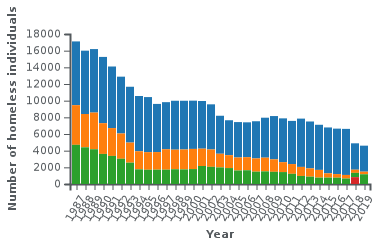Homelessness in Finland
Homelessness in Finland affects approximately 5 thousand people.[1] In 2018, the total amount of homeless people was 5,482.[1][lower-alpha 1]
| Homeless people living alone in Finland (1987–2019) | |
 | |
| Legend:
Temporarily living with friends and relatives | |
| Homeless families and couples in Finland (1987–2019) | |
 | |
| Source: The Housing Finance and Development Centre of Finland[1] | |
Finland is the only European Union country where homelessness is currently falling.[2] The country has adopted a Housing First policy, whereby social services assign homeless individuals rental homes first, and issues like mental health and substance abuse are treated second.[3][4] Since its launch in 2008, the number of homeless people in Finland has decreased by roughly 30%,[1] and the number of long-term homeless people has fallen by more than 35%.[2] "Sleeping rough", the practice of sleeping outside, has been largely eradicated in Helsinki, where only one 50-bed night shelter remains.[2]
The Constitution of Finland mandates that public authorities "promote the right of everyone to housing".[5] In addition, the constitution grants Finnish citizens "the right to receive indispensable subsistence and care", if needed.[5]
Since 2002, the Night of the Homeless event has been hosted throughout the country.[6] The events include demonstrations, food distribution, and movie screenings, among other activities.[7]
Statistics
Since 1987, the Housing Finance and Development Centre of Finland (Finnish: Asumisen rahoitus- ja kehittämiskeskus; ARA) has been publishing annual statistics related to homelessness. The figures are collected independently by the municipalities of Finland, leading to minor inconsistencies in reporting. ARA publishes data on homeless families and homeless people living alone separately.
The majority of homeless people reside in larger cities, notably in the capital region. Over 60 percent of Finland's homeless population resides in the Greater Helsinki area.[4] Homelessness disproportionately affects men, although this gap has been reduced due to recent efforts. Roughly three out of four homeless individuals are male.[1]
Some key figures for homeless people in Finland (2019) include the following:[1]
- 21% of the homeless are considered long-term homeless[lower-alpha 2]
- 26% of the homeless are female
- 18% of the homeless are young (under 25 years old)
- 24% of the homeless are immigrants
Notes
- ARA has not published the total homeless population figure (including families) for 2019. In 2019, there were 3,120 homeless individuals living alone and 264 homeless families.[1]
- ARA defines long-term homelessness as the following:[1]
"Long-term homelessness refers to a homeless person who has a significant social or a health problem, such as debt, substance abuse or mental health problems, and whose homelessness has been prolonged or is in danger of being prolonged due to a lack of conventional housing solutions and appropriate support services. Homelessness is considered long-term if it has lasted for at least one year or if the individual has repeatedly experienced homelessness over the last three years."
References
- The Housing Finance and Development Centre of Finland (ARA) (2020). "Homelessness Reports". ara.fi. Retrieved 13 April 2020.
- Henley, Jon (3 June 2019). "'It's a miracle': Helsinki's radical solution to homelessness". The Guardian. Retrieved 2020-01-17.
- Pohjanpalo, Kati (19 July 2019). "American Idea Inspires Finland to Slash Homelessness by 40%". Bloomberg News. Retrieved 13 April 2020.
- Y-Foundation. "Housing First in Finland". ysaatio.fi. Retrieved 13 April 2020.
- Ministry of Justice, Finland. "The Constitution of Finland" (PDF). finlex.fi. Retrieved 13 April 2020.
- "In English - Asunnottomien yö -kansalaisliike". asunnottomienyo.fi/. Retrieved 13 April 2020.
- "Night of the Homeless highlights women". Yle. 17 October 2019. Retrieved 13 April 2020.